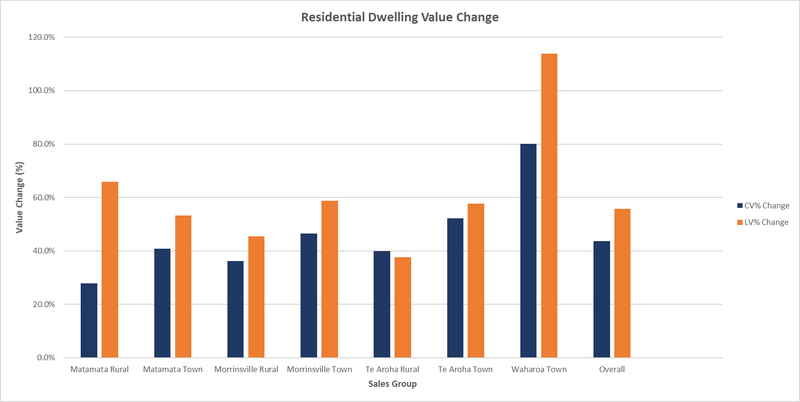New rating valuations for Matamata-Piako District

Matamata-Piako District property owners will soon receive a Notice of Rating Valuation in the post with an updated rating value for their property.
The new rating valuations have been prepared for 15,534 properties on behalf of the Matamata-Piako District Council by Quotable Value (QV). They show the total rateable value for the district is now $19,164,705,450 with the land value of those properties now valued at $12,151,719,150.
On average, the value of residential housing has increased 43.7% since 2018 with the average house value now sitting at $686,000, while the corresponding average land value increased by 55.7% to an average of $333,000.
QV Area Manager Jarrod Hedley commented: “The demand for residential housing has been very buoyant across the district, heightened since the initial 2020 COVID lockdown, with the three main townships seeing increases of between 40-52% overall since the 2018 revaluation. Demand for vacant land has also been strong and as a result residential land values have increased between 53-59% for the district overall.”
“We have seen significant value lifts across the entire residential market since 2018 with values only now starting to stabilise in the last month or so past the revaluation date. Lower-value properties have seen the most competition from buyers, resulting in some of the greatest value increases. Demand from buyers coming from outside the region has also helped fuel the market. Greenfield developments in Morrinsville and Matamata continue to attract population growth to the district,” Mr Hedley added.

Commercial, industrial, rural + lifestyle properties
Meanwhile, commercial property values have increased by 32% and property values in the industrial sector have increased by 35.5% since the district’s last rating valuation in 2018. Commercial and industrial land values have also increased by 61% and 44% respectively.
“Retail and office properties have seen lower increases in value than the residential property market, but they have still increased well off the back of strengthening yields,” said Mr Hedley. “While there is demand from buyers for good-quality properties with favourable leases in place, this has been offset to some degree by online competition for retailers and the start of a post-lockdown trend for more people to work from home. We have seen steady value increases for industrial properties, and a limited supply of industrial land within the region has certainly helped support this increase.”
Since 2018, the average capital value of an improved lifestyle property has increased by 31% to $1,033,000, while the corresponding land value for a lifestyle property increased by 41% to $640,000.
Mr Hedley said lifestyle properties typically aligned in value with high-end residential properties. “This segment of the market has been buoyant. A smaller market and less demand has meant there has not been quite the same increase in the land values as seen in the residential market,” he said.
“The dairy farm market showed little change in value off the back of high value levels set in 2018. After a sustained subdued period of market uncertainties and volatility, investor appetite has begun to reappear in rural markets, particularly dairy. Whilst dairy values slightly declined overall, smaller blocks of up to 30 hectares saw a slight increase off the back of stronger demand, along with pastoral properties.”
What are rating valuations?
Rating valuations are usually carried out on all New Zealand properties every three years to help local councils set rates for the following three-year period. They reflect the likely selling price of a property at the effective revaluation date, which was 1 July 2021, and do not include chattels.
Rating valuations are NOT designed to be used as market valuations for raising finance with banks or as insurance valuations. They are independently audited by the Office of the Valuer General and need to meet rigorous quality standards before the new rating valuations are certified.
It is helpful to remember the effective rating revaluation date of 1 July 2021 has passed and any changes in the market since then will not be included in the new rating valuations. This means in many cases a sale price achieved in the market today may be different to the new rating valuation — especially in this fast-moving residential property market.
New rating values will be posted to property owners after 28 October 2021. If owners do not agree with their rating valuation, they have a right to object through the objection process before 2 December 2021.



